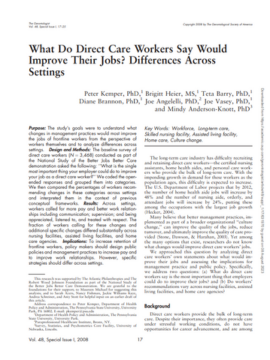What Do Direct Care Workers Say Would Improve Their Jobs? Differences Across Settings
In response to a competitive request for proposals, the demonstration selected nonprofit agencies leading coalitions of stakeholders in five states—Iowa, North Carolina, Oregon, Pennsylvania, and Vermont—to participate in a 3-year demonstration of a variety of policy initiatives and management practice interventions.
Author: Peter Kemper, Brigitt Heier, Teta Barry, Diane Brannon, Joe Angelelli, Joe Vasey, Mindy ANderson-Knott
Publication Date: July 1, 2008
Description:
Purpose: The study's goals were to understand what changes in management practices would most improve the jobs of frontline workers from the perspective of workers themselves and to analyze differences across settings.
Design and Methods: The baseline survey of direct care workers (N = 3,468) conducted as part of the National Study of the Better Jobs Better Care demonstration asked the following: “What is the single most important thing your employer could do to improve your job as a direct care worker?” We coded the open-ended responses and grouped them into categories. We then compared the percentages of workers recommending changes in these categories across settings and interpreted them in the context of previous conceptual frameworks.
Results: Across settings, workers called for more pay and better work relationships including communication; supervision; and being appreciated, listened to, and treated with respect. The fraction of workers calling for these changes and additional specific changes differed substantially across nursing facilities, assisted living facilities, and home care agencies.
Implications: To increase retention of frontline workers, policy makers should design public policies and management practices to increase pay and to improve work relationships. However, specific strategies should differ across settings.
Access: Free
Keywords: Workforce, long-term care, skilled nursing facility, assisted living facility, home care, culture change



